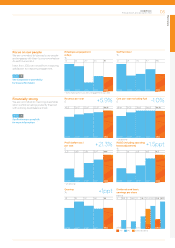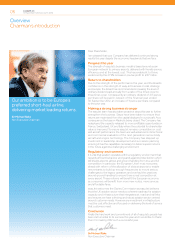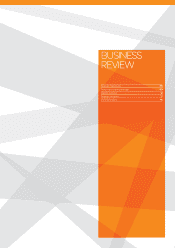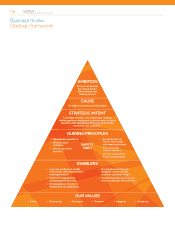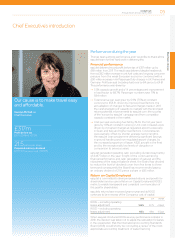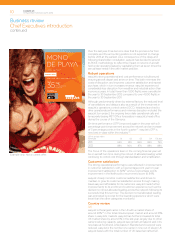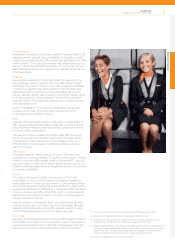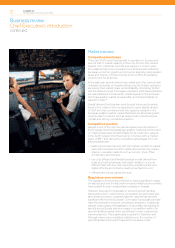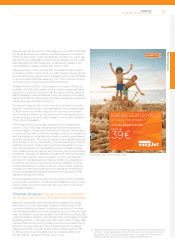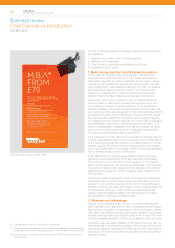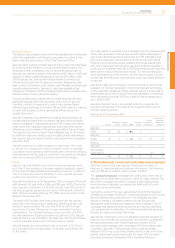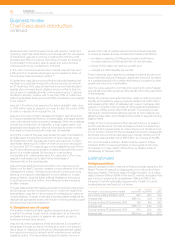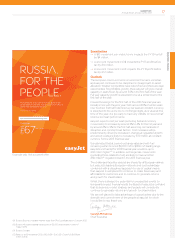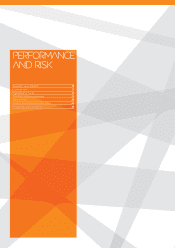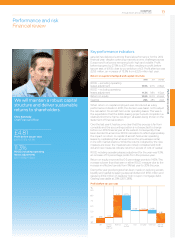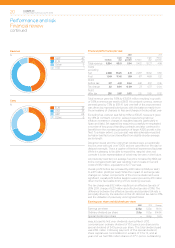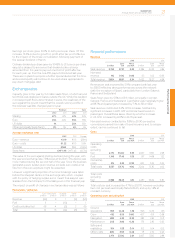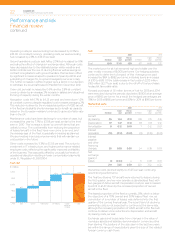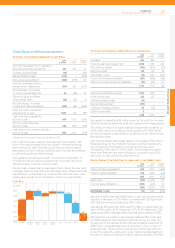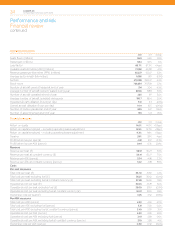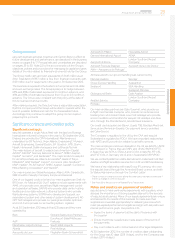EasyJet 2012 Annual Report Download - page 17
Download and view the complete annual report
Please find page 17 of the 2012 EasyJet annual report below. You can navigate through the pages in the report by either clicking on the pages listed below, or by using the keyword search tool below to find specific information within the annual report.
The major airframe suppliers have embarked upon the development
of the next generation of short-haul aircraft to take advantage of
new engine technology being developed by CFM International (a
joint venture between General Electric and Snecma) and Pratt &
Whitney. Airbus and Boeing are updating their single aisle aircraft
with new engines and various other upgrades whilst Bombardier is
producing a completely new 100 to 150 seat family aircraft using the
latest systems and production techniques. The new aircraft types,
which are planned to enter service over the next six years, promise
double digit fuel efficiency improvements which are clearly attractive
to easyJet.
easyJet is making good progress on its technical and commercial
evaluation of the next generation of short-haul aircraft technology.
As the evaluation advances further, easyJet will bring a proposal to
shareholders which will cover both the next generation of deliveries
which are likely to be after 2017 and a plan for the bridging period
from 2014 to 2017.
easyJet’s intention for any new aircraft order is to maximise the
economic efficiencies of the fleet and to support further returns-
focused capacity growth.
Fleet as at 30 September 2012:
Owned
Operating
leases
Finance
leases Total
Changes
in year
Future
committed
deliveries(7)
Unexercised
purchase
rights and
options(8)
easyJet
A319 105 49 6 160 -7 – –
easyJet
A320 43 6 5 54 19 16 73
Boeing
737-700 ––––-2 – –
GB Airways
A320 family –––––2
(6) –
148 55 11 214 10 18 73
3. Drive demand, conversion and yields across Europe
Over the course of the year, easyJet introduced a number of
initiatives to drive demand and improve unit revenue. Unit revenues
rose by 7.5% on a constant currency basis to £59.41.
The “europe by easyJet” campaign has continued to drive visits to
easyJet.com and has been a success in all of its major markets. The
aim of the campaign has been to develop a brand that people
know, like and understand, increasing their likelihood to fly with
easyJet on a recurring basis.
During the course of the year, easyJet launched its first television
advertising campaign focusing on connecting people across Europe
and the experiences customers have. The emphasis has been
placed on having a consistent presence across Europe with
appropriate market testing and tailoring of key messages. The TV
campaign was delivered at the same time as reducing marketing
cost per seat with a reallocation of marketing investment achieved
through the rigorous testing of all media.
easyJet has continued to focus on attracting business travellers to
improve unit revenues. Key to success in this market is to establish
effective partnerships with Global Distribution System (GDS)
providers, travel management companies (TMCs) and large scale
corporate customers. The emphasis of the business traveller
initiative in 2012 was to put these building blocks in place for future
growth. Agreements were signed with the major GDS providers
(including Amadeus), the leading TMCs (including American
easyJet Lean
The easyJet Lean programme is now firmly established and embedded
within the organisation with targets every year on a rolling 5 year
basis under the sponsorship of the Chief Financial Officer.
easyJet Lean’s goal is to protect easyJet’s structural cost advantage
by ensuring below inflation non-fuel cost per seat increases. The
emphasis is both on keeping cost out as well as taking cost out.
easyJet Lean delivered ahead of the planned £90 million in 2012 and
expects to deliver additional savings of around £35 million in the
2013 financial year. Savings are being achieved by driving cost
efficiencies through best in-class procurement, leveraging scale,
tight control of overhead costs, greater crew flexibility and improved
operational performance. Savings to date have partially offset
inflationary increases and the increased investments in infrastructure
developments including allocated seating.
Ground handling was a target area in the last financial year and
significant savings have been achieved. Over a third of ground
handling contracts measured by spend were renegotiated,
delivering typical savings of between 5% and 15%. easyJet continues
to work with suppliers to drive operational efficiencies and to
simplify its product.
easyJet’s strategy is focused around building strong positions at
primary airports where there is inherent demand and thus higher
yields are available. Consequently around 70% of easyJet’s airport
costs come from regulated airports and there have been above
inflationary cost increases in the period especially in Italy and Spain.
The easyJet procurement team have mitigated part of the impact
by putting in place key deals to support asset growth elsewhere in
the network. easyJet expects further cost pressure from regulated
airports in 2013.
easyJet continues to make progress in optimising crew costs
toensure it is competitive in each market in which it operates.
Successes include agreeing more flexibility with crew and increasing
crew planning horizons. easyJet continues to recognise and engage
with unions during a difficult economic time for the industry.
Fleet
easyJet has built flexibility into its fleet planning arrangements
suchthat it can increase or decrease capacity deployed, subject
tothe opportunities available and prevailing economic conditions.
The Company also has the flexibility to move aircraft between
routes and markets to improve returns.
easyJet’s total fleet as at 30 September 2012 comprised 214 aircraft,
split between 156 seat Airbus A319s and 180 seat A320s. During the
year, easyJet took delivery of 19 A320 aircraft under the terms of
the Airbus easyJet agreement and seven A319 aircraft exited the
fleet. The two remaining Boeing 737-700s were returned to their
lessors in November 2011.
The larger A320 aircraft have been introduced over the last few
years with minimal reduction in yields, and deliver a per seat cost
saving of approximately 7% over the A319 aircraft through
economies of scale, efficiencies in crew, ownership, fuel and
maintenance. The modest increase in the proportion of A320s
thisyear delivered a 21 pence per seat cost saving in 2012. easyJet
believes that the mix of A320s in the fleet can continue to increase
in the foreseeable future with minimal impact on yields.
easyJet targets an owned:leased split of aircraft of 70:30 but,
asitevaluates the next generation of aircraft, expects the mix
tofluctuate.
Business review
easyJet plc
Annual report and accounts 2012 15


